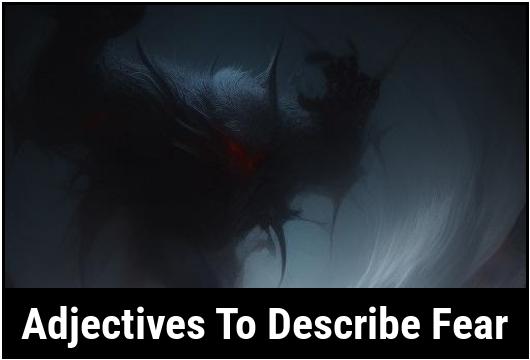- You are here:
- Home »
- adjectives
- » 31 Adjectives To Describe Fear

31 Adjectives To Describe Fear
Fear is a powerful and complex emotion that can manifest in various ways, and finding the right words to describe it can be challenging. Adjectives play a crucial role in articulating the nuances and intensity of fear. They can evoke vivid imagery and emotion, offering a deeper understanding of the experience of fear. In this article, we will explore the significance of using adjectives to describe fear and delve into various types of adjectives that can effectively capture the essence of fear.
Key Takeaways
- Adjectives are essential in conveying the intensity, nature, and impact of fear.
- Descriptive adjectives can create vivid imagery and evoke strong emotional responses.
- Various types of adjectives can be used to capture different aspects of fear, including physical, psychological, and situational dimensions.
Adjectives To Describe Fear
1. Terrifying
Fear can be described as terrifying when it overwhelms and paralyzes us, leaving us completely helpless.
2. Intense
Fear often manifests as an intense emotion, creating a strong sensation that can be physically felt in our bodies.
3. Unnerving
Fear can be unnerving, unsettling us and causing a sense of discomfort and unease.
4. Numbing
In moments of fear, our emotions can become numb, stifling our ability to effectively process and deal with the situation.
5. Debilitating
Fear can be debilitating, rendering us unable to perform daily tasks or make rational decisions due to its overwhelming grip on our minds.
6. Petrifying
When fear reaches a peak, it can be described as petrifying, leaving us frozen in terror.
7. Chilling
Fear possesses a chilling quality, often sending shivers down our spines and leaving us with an eerie sensation.
8. Crippling
Fear has the power to cripple us emotionally, mentally, and sometimes even physically.
9. Suffocating
In the face of fear, it can feel as if we are being suffocated, unable to breathe freely or escape its clutches.
10. Overpowering
Fear can become overpowering, taking control of our thoughts, actions, and perceptions.
11. Dismaying
Fear often leaves us in a state of dismay, filling us with distress, disappointment, or discouragement.
12. Consuming
Fear can be all-consuming, occupying our minds entirely and leaving little space for anything else.
13. Paralyzing
Fear can paralyze us, trapping us in a state of immobility and preventing us from taking necessary action.
14. Haunting
Some fears can be haunting, persistently lingering in our minds and causing distress even when the danger has passed.
15. Heart-pounding
Fear can accelerate our heartbeat, causing it to pound rapidly and loudly against our chest.
16. Gut-wrenching
Fear can evoke a gut-wrenching sensation, as if someone is tightening a knot in the pit of our stomach.
17. Hair-raising
Fear may cause our hair to stand on end, creating an electrifying and hair-raising experience.
18. Bone-chilling
When fear reaches its deepest depths, it can be described as bone-chilling, sending a shiver down to our very core.
19. Panic-inducing
Certain fears can be panic-inducing, triggering a surge of anxiety and making it difficult to remain calm.
20. Overwhelming
Fear can become overwhelming, flooding our senses and making it challenging to think clearly or act logically.
21. Claustrophobic
Fear can create a sense of claustrophobia, as if we are trapped in a confined space with no escape route.
22. Foreboding
Fear can be accompanied by an ominous sense of foreboding, as if something terrible is about to happen.
23. Suffocating
Fear can make us feel as if we are suffocating, as if it is closing in on us from all sides, leaving no room to breathe.
24. Sweaty palms
One physical manifestation of fear is sweaty palms, a natural response caused by heightened anxiety.
25. Quivering
Fear can cause our bodies to quiver or tremble involuntarily, indicating the intensity of our emotional state.
26. Heart-stopping
When fear reaches its zenith, it can leave us with a heart-stopping sensation, momentarily dampening our vitality.
27. Breathless
Fear can temporarily rob us of our breath, making it challenging to take in air and leaving us gasping for breath.
28. Jittery
Fear often manifests as a feeling of nervousness or jumpiness, making us jittery and on edge.
29. Nightmarish
Certain fears can be so extreme that they resemble a waking nightmare, causing immense distress and anxiety.
30. Tremendous
Fear can be tremendous in its magnitude, eliciting a profound impact on our lives and overall well-being.
31. Formidable
At times, fear can be described as formidable, appearing indomitable and posing a great challenge to conquer.
Why Use Adjectives To Describe Fear
Using adjectives to describe fear enables precision and depth in communication. Fear is a complex and multifaceted emotion, encompassing a wide range of experiences and reactions. Adjectives serve as intricate tools that allow us to convey the varying degrees, qualities, and implications of fear. Furthermore, adjectives aid in creating compelling narratives and evoking empathetic responses by providing a detailed portrayal of the fear experience.
In literature, film, and art, adjectives are crucial in building immersive environments and eliciting emotional responses from audiences. They guide the audience’s perception and interpretation of fear, shaping their empathy and connection with the characters or subjects embodying fear. In everyday conversation, adjectives enrich dialogue by offering nuanced descriptions of fear, enhancing mutual understanding and empathy among individuals.
How To Choose The Right Adjective To Describe Fear
Selecting the appropriate adjectives to describe fear requires a deep understanding of the specific context, intensity, and manifestations of fear. The chosen adjectives should accurately capture the emotional, physiological, and psychological aspects of fear to effectively communicate its impact and significance.
When choosing adjectives to describe fear, consider the following factors:
- Context: Understand the setting, circumstances, and triggers of fear.
- Intensity: Assess the degree of fear, whether it is mild, moderate, or intense.
- Manifestations: Consider the physical, cognitive, and behavioral expressions of fear.
- Impact: Evaluate the repercussions and influence of fear on individuals or situations.
By considering these factors, one can select adjectives that vividly depict the nature of fear and resonate with the audience or reader.
Types Of Adjectives For Describing Fear
Physical Adjectives
Physical adjectives are used to portray the bodily sensations and reactions associated with fear. These adjectives vividly capture the physiological manifestations of fear, providing a tangible representation of the experience.
- Trembling: "Her trembling hands betrayed her underlying fear."
- Sweaty: "A blanket of sweaty palms gripped the room in fearful anticipation."
- Pounding: "The pounding heart echoed the rhythm of fear within her chest."
- Tense: "His tense muscles reflected the fear that coursed through his body."
- Pale: "The pallor of her face revealed her profound fear."
Psychological Adjectives
Psychological adjectives delve into the cognitive and emotional dimensions of fear, elucidating the mental and affective aspects of the experience.
- Anxious: "Her anxious mind raced with fearful scenarios."
- Dreadful: "The dreadful anticipation of fear hung heavy in the air."
- Paralyzing: "The paralyzing fear rendered him motionless."
- Overwhelming: "An overwhelming sense of fear consumed her thoughts."
- Terrifying: "The terrifying imagery induced a profound sense of fear."
Situational Adjectives
Situational adjectives contextualize fear within specific scenarios, environments, or conditions, capturing the contextual essence of fear.
- Foreboding: "The foreboding atmosphere intensified their fear."
- Menacing: "The menacing shadows cast an aura of fear over the desolate alley."
- Ominous: "The ominous silence filled the room with a palpable fear."
- Perilous: "The perilous situation ignited a primal sense of fear within them."
- Vulnerable: "The vulnerable state of isolation amplified their fear."
Comparative Adjectives
Comparative adjectives establish degrees of fear, allowing for a nuanced depiction of the intensity or severity of the emotion.
- Intensifying: "The intensifying fear gripped her with escalating unease."
- Heightened: "The heightened sense of fear permeated the room, raising tension."
- Excruciating: "An excruciating fear engulfed him, surpassing all prior experiences."
- Pervasive: "A pervasive fear settled over the crowd, leaving no one untouched."
- Unabating: "The unabating fear persisted, unabated by reassurances."
Descriptive Adjectives
Descriptive adjectives encapsulate the varied qualities and characteristics of fear, offering a comprehensive portrayal of the emotion.
- Inescapable: "The inescapable fear rooted itself deep within his psyche."
- Ethereal: "An ethereal sense of fear permeated the surreal landscape."
- Eerie: "The eerie stillness carried an unsettling undercurrent of fear."
- Claustrophobic: "The claustrophobic fear confined their thoughts and actions."
- Haunting: "A haunting fear lingered in the aftermath of the harrowing experience."
Adjectives are indispensable linguistic tools that enable us to vividly articulate the multi-faceted nature of fear. By employing descriptive, situational, psychological, physical, comparative, and other types of adjectives, we can accurately capture the essence of fear and convey its impact with depth and precision. Choosing the right adjectives to describe fear involves a comprehensive understanding of the context, manifestations, and intensity of fear, and it enriches our ability to communicate, empathize, and create immersive narratives. In harnessing the power of adjectives, we unveil the intricate tapestry of fear, illuminating its visceral and emotional dimensions in all their complexity.
Examples Of Adjectives For Different Types Of Fear
Fear is a basic human emotion that can be triggered by a wide range of situations and experiences. Adjectives are an essential part of language that allow us to describe and express emotions, including fear. Adjectives help us convey the intensity, nature, and specific characteristics of fear.
-
Intense fear: When fear is extremely strong and overwhelming, we can use adjectives such as "terrifying," "horrifying," or "petrifying" to convey its intensity. For instance, someone who is terrified of heights may say, "I have a petrifying fear of standing on tall buildings."
-
Nervous fear: This type of fear is characterized by anxiety and uneasiness. Adjectives like "anxious," "apprehensive," or "edgy" can be used to describe this type of fear. For example, someone who is apprehensive about public speaking might say, "I feel anxious and edgy whenever I have to give a presentation."
-
Paralyzing fear: When fear renders a person unable to move or act, it can be described as "paralyzing" or "paralyzing." This type of fear can be so overpowering that it immobilizes a person. For instance, a person with a phobia of spiders may say, "The sight of a spider paralyzes me with fear."
-
Dreadful fear: Fear that is accompanied by a sense of impending doom or terror can be described as "dreadful." This adjective is often used to describe fear that is linked to a specific event or situation. For example, someone who is terrified of flying may say, "The thought of getting on a plane fills me with dreadful fear."
-
Gut-wrenching fear: Fear that causes physical discomfort or a feeling of sickness in the stomach can be described as "gut-wrenching." This adjective is often used to convey fear that is associated with a deep emotional response. For instance, a person who is scared of confrontation may say, "The idea of having a difficult conversation with my boss is gut-wrenching."
-
Inexplicable fear: Sometimes fear arises without any apparent reason or cause. This type of fear can be described as "unexplainable," "irrational," or "unfounded." For example, someone who is afraid of balloons with no known traumatic experience may say, "My fear of balloons is completely irrational and unexplainable."
-
Trembling fear: Fear that causes physical trembling or shaking can be described as "trembling" or "shaking." This adjective highlights the physical manifestations of fear. For instance, someone who is afraid of public speaking may say, "I always start shaking with fear whenever I have to speak in front of a large audience."
-
Chilling fear: Fear that sends shivers down one’s spine or creates a sense of coldness can be described as "chilling" or "bone-chilling." This adjective is often used to convey fear that is associated with a sense of horror or terror. For example, someone who is scared of horror movies may say, "Watching that scene was absolutely bone-chilling."
-
Ominous fear: Fear that is accompanied by a sense of foreboding or impending danger can be described as "ominous" or "foreboding." This adjective is often used to describe fear that is linked to a sense of the unknown. For instance, someone who is afraid of the dark may say, "Walking alone in the dark gives me an ominous sense of fear."
-
Crippling fear: Fear that debilitates and impairs a person’s ability to function can be described as "crippling." This adjective expresses the extent to which fear can immobilize someone. For example, someone with a fear of water may say, "My fear of swimming is so crippling that I can’t even go near a pool."
Common Mistakes In Using Adjectives To Describe Fear
Using adjectives to describe fear can be tricky, and there are some common mistakes that writers often make. It’s important to be aware of these mistakes to effectively convey the intended meaning. Here are some common mistakes to avoid:
-
Overusing generic adjectives: Using generic and overused adjectives such as "scared" or "afraid" can make your writing dull and lack creativity. While these adjectives can be useful in certain contexts, it’s essential to vary your word choice and explore more specific adjectives that vividly capture the nuances of fear.
-
Using inappropriate adjectives: Choosing adjectives that are not appropriate for the context can confuse the reader and weaken the impact of your writing. For instance, using mild adjectives like "slightly scared" to describe intense fear can undermine the intended effect. It’s important to choose adjectives that accurately reflect the intensity and nature of the fear being described.
-
Neglecting to provide context: Merely using adjectives to describe fear without providing context can leave the reader confused or disconnected from the emotion being conveyed. It’s important to provide sufficient background information or describe the situation that triggers the fear to help the reader fully understand and empathize.
-
Ignoring the impact of adverbial phrases: Adjectives can be enhanced when used in conjunction with adverbial phrases that provide additional information about the fear being described. For instance, instead of saying "I am scared of spiders," you could say, "I am absolutely terrified of spiders." Adding an adverbial phrase intensifies the adjective and paints a more vivid picture for the reader.
-
Failing to consider cultural differences: It’s crucial to be mindful of cultural differences when using adjectives to describe fear. Different cultures may have varying interpretations and associations with certain adjectives. What may be seen as fearful in one culture may not have the same impact in another. Considering cultural context helps ensure that the adjectives accurately convey the intended meaning.
Using Adjectives Effectively
To effectively use adjectives to describe fear, consider the following tips:
-
Choose vivid and specific adjectives: Rather than relying on generic adjectives, explore a variety of adjectives that vividly convey the specific nature and intensity of fear. Consider using words that evoke strong imagery and emotions.
-
Use sensory language: Incorporating sensory language when describing fear can enhance the reader’s experience and make it more immersive. Describe how fear feels, sounds, tastes, smells, and looks. For example, instead of saying, "He was scared of the dark," you could say, "He felt a cold shiver crawl up his spine as darkness engulfed him."
-
Provide context: To ensure that the reader fully understands the fear being described, provide context. Describe the situation, event, or trigger that elicits the fear. This helps the reader empathize with the emotion and creates a more engaging reading experience.
-
Consider the character’s perspective: When using adjectives to describe fear in a story or narrative, consider the character’s perspective. Think about how fear might be perceived and experienced through their eyes. This helps create a more authentic and relatable portrayal of fear.
-
Balance adjectives with action: While adjectives are essential for describing fear, it’s important to balance them with action. Show the character’s response to fear through their thoughts, behaviors, and dialogue. This adds depth and complexity to the portrayal of fear.
-
Revise and edit: After writing a passage that includes adjectives to describe fear, take the time to revise and edit. Read the passage aloud to ensure that the adjectives effectively convey the intended meaning and evoke the desired emotion. Look for opportunities to enhance the language and make it more impactful.
Exercises And Practice
To practice using adjectives to describe fear, you can try the following exercises:
-
Describe fear using a different adjective: Take a simple sentence such as "I am scared of spiders" and try replacing the adjective with a different one. For example, "I am petrified of spiders" or "I am horrified by spiders." Experiment with different adjectives to see how they change the meaning and impact of the sentence.
-
Write a short paragraph with sensory language: Choose a specific fear and write a short paragraph using sensory language to describe it. Consider how fear feels, sounds, tastes, smells, and looks. For example, if you’re describing a fear of heights, you could write, "As I stood on the edge of the precipice, my heart raced, and my legs trembled uncontrollably. The gusts of wind roared in my ears, and the acrid scent of fear permeated the air."
-
Create a character’s perspective: Imagine a character who experiences a unique fear. Write a short scene from their perspective, including their thoughts, emotions, and reactions to the fear. Consider how the character’s background and experiences shape their perception of fear.
Conclusion
Adjectives play a crucial role in describing fear and capturing its intensity, nature, and specific characteristics. By using vivid and specific adjectives, incorporating sensory language, providing context, and considering the character’s perspective, you can effectively convey fear to your readers. By avoiding common mistakes and practicing the use of adjectives, you can enhance your writing and create a more immersive experience for your audience. Happy writing!
FAQS On Adjectives To Describe Fear
What Are Some Common Adjectives Used To Describe Fear?
Some common adjectives used to describe fear include: terrifying, paralyzing, gut-wrenching, overwhelming, and bone-chilling.
Can You Explain The Difference Between "terrifying" And "paralyzing" In The Context Of Describing Fear?
"Terrifying" refers to something that causes extreme fear or dread, while "paralyzing" describes a fear that is so intense it can render someone immobile or unable to act.
What Do Words Like "gut-wrenching" And "bone-chilling" Convey When Describing Fear?
These types of adjectives suggest a physical reaction to fear, such as a feeling in the pit of one’s stomach or a shiver down the spine.
Are There Any Adjectives That Can Describe A Fear That Is More Subtle Or Underlying?
Yes, adjectives like "nagging," "persistent," or "insidious" can be used to describe a fear that lingers in the back of someone’s mind or manifests in a subtle, continual way.
How Can Using Specific Adjectives Enhance Writing When Describing Fear?
Adding descriptive adjectives to fear-related writing can evoke a more vivid image and help readers connect with the emotion being conveyed. It can also add depth and intensity to the fear being described.









